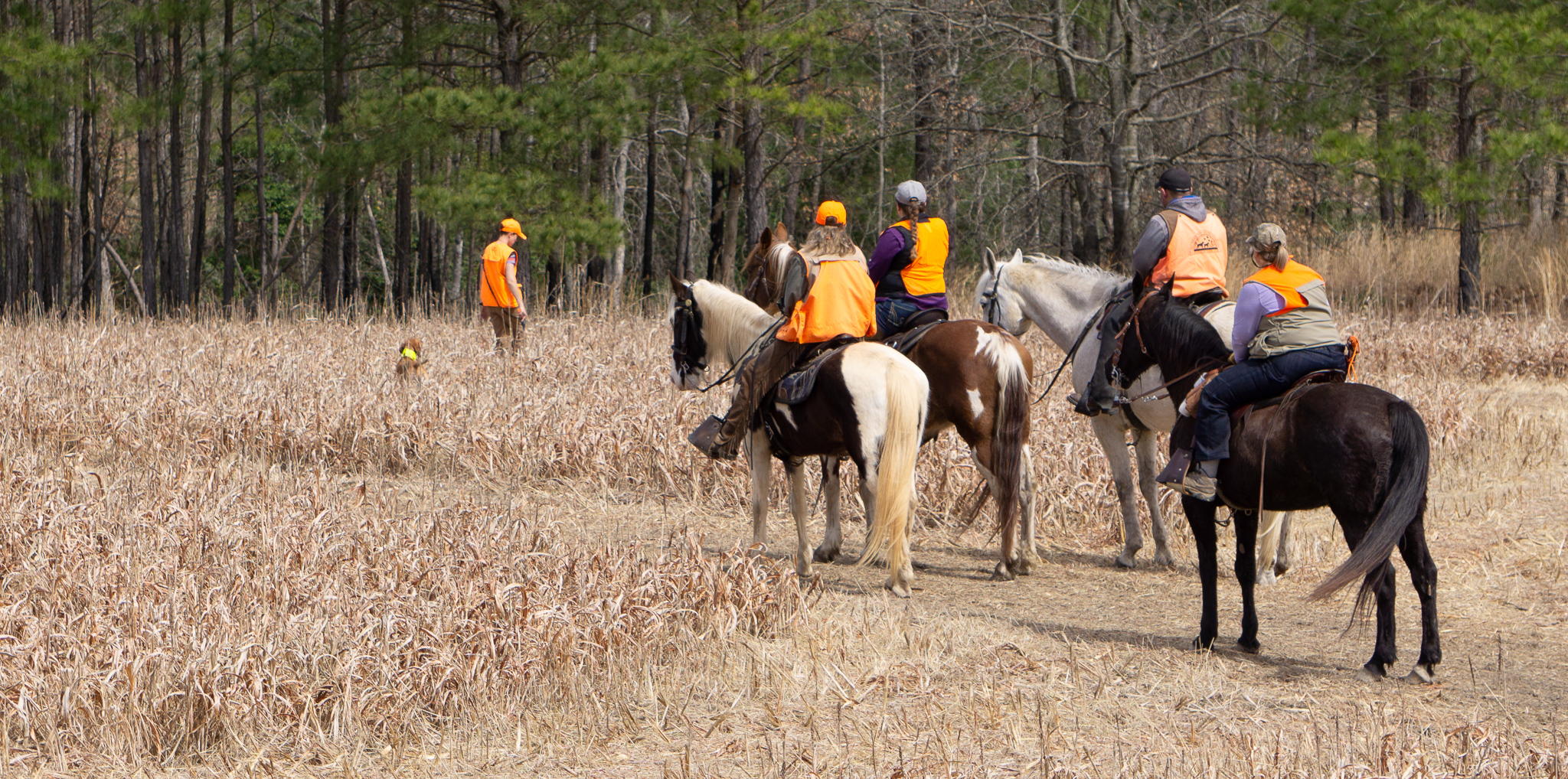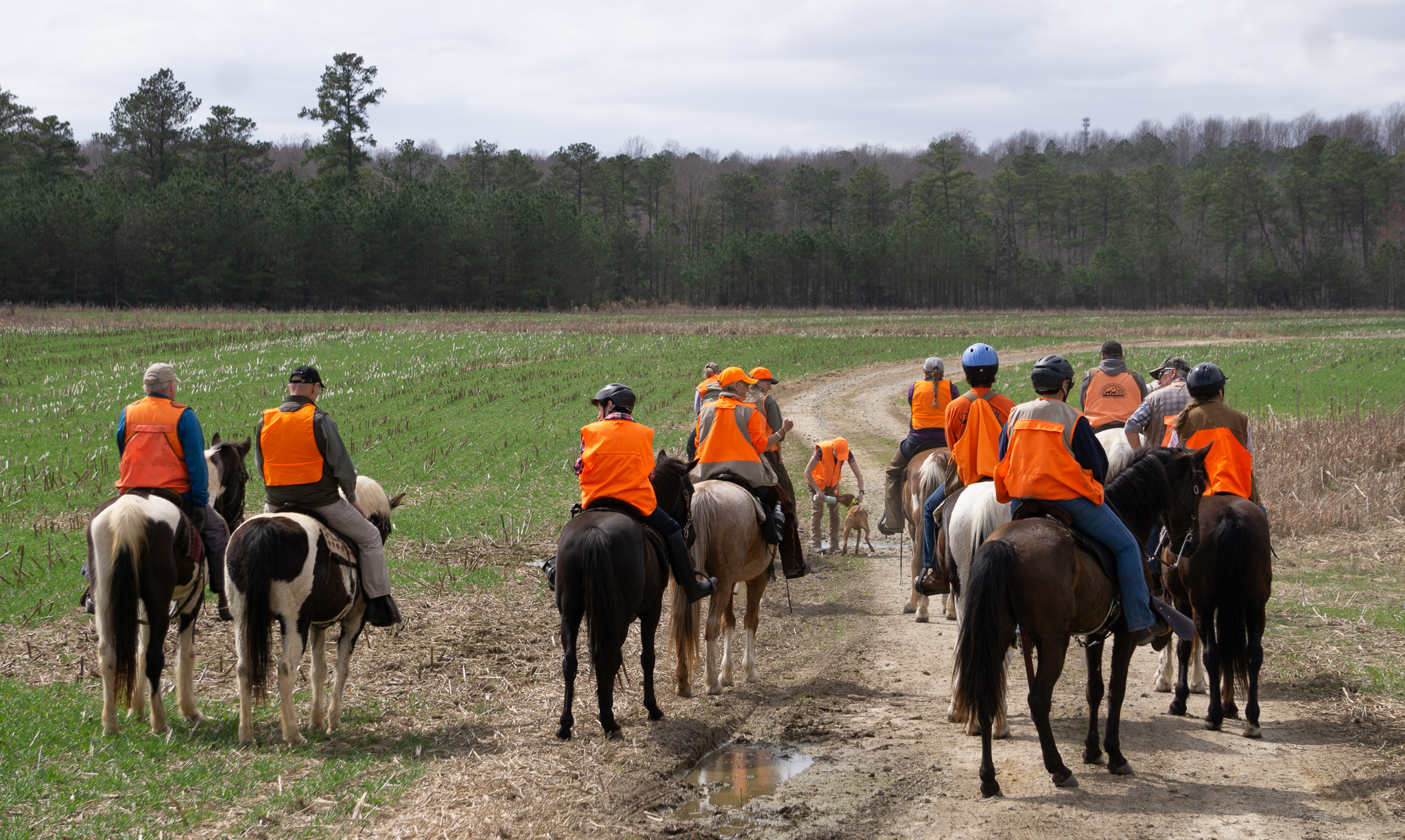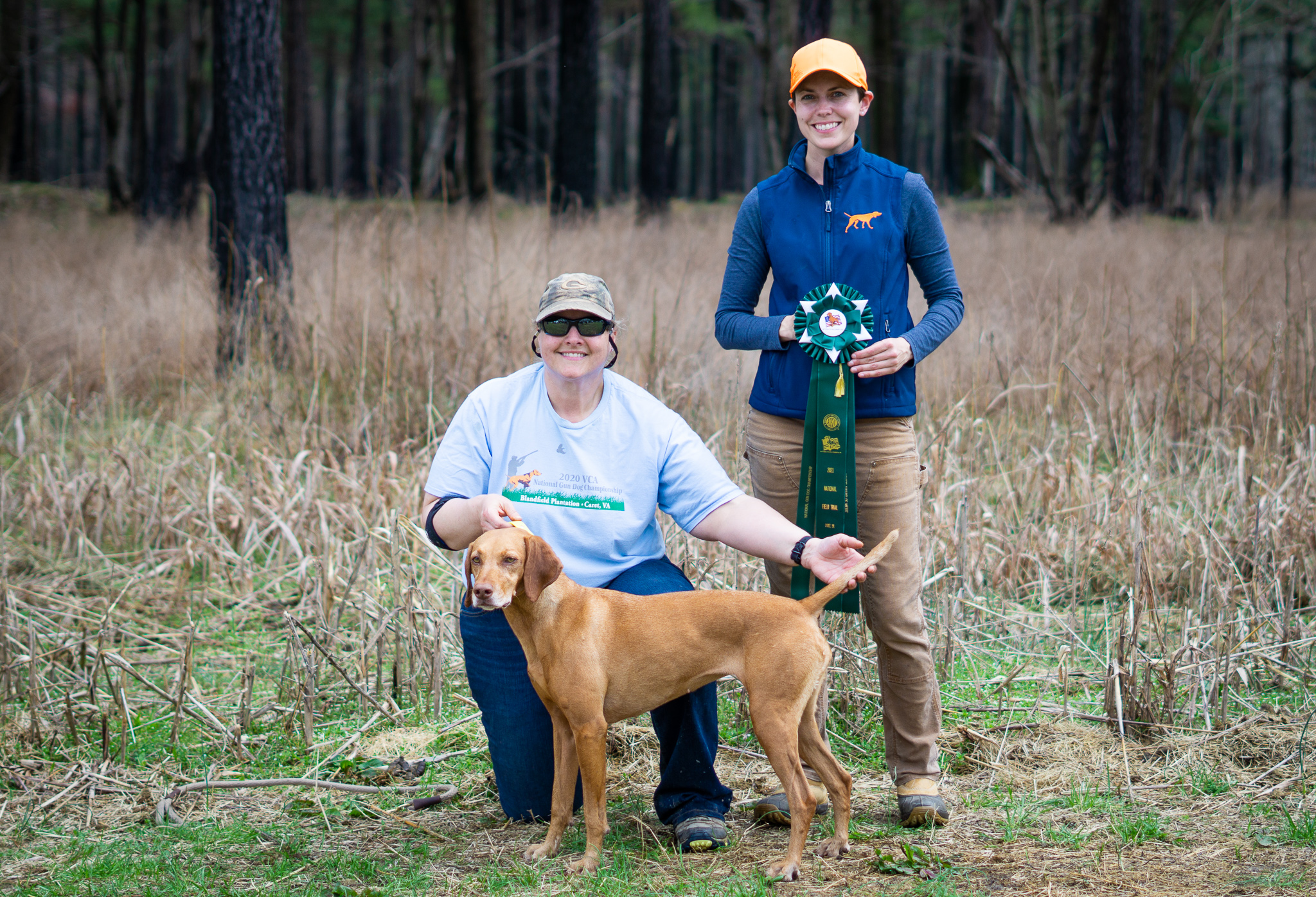About a month ago, Zara and I had the chance to participate in the Vizsla Club of America‘s National Gun Dog Championship. It was held at the Blandfield Plantation, in Caret, Virginia, which is about 3 hours and 20 minutes from my house. The NGDC is held once a year in the spring and it moves around the country. In order to qualify for the NGDC, a vizsla has to have earned a field trial placement in a major stake or a Master Hunter title. It is a walking field trial with retrieving where dogs are run in braces of two for one hour.
Qualifying for the National Gun Dog Championship
I first found out about the NGDC in late 2019, when I was talking to a woman, Melissa Thomas, who has owned vizslas for a long time and judges hunt tests. I had reached out to her to find out more about running AKC Senior Hunt Tests, since the AKC rulebook was a little vague on what was required at the Senior level. She mentioned that the Vizsla Club of America was holding their NGDC in Virginia in 2020, and I should enter if I could get Zara’s Master Hunter title in time. Although I was intrigued, I wasn’t sure that Zara would be ready for MH in the next few months. At the time, I still didn’t have a place to train on my own, so I was unable to teach Zara proper backing and stop to flush behaviors, which are essential for MH.
As luck would have it, the onset of COVID-19 ended up postponing the NGDC to 2021 in the same location. As we headed into the winter of 2020/2021, I had my sights set on earning Zara’s Master Hunter title with the ultimate goal of attending the NGDC. We cut it close, earning her MH one week before the entries to the NGDC closed. I sent in my entry form and was excited for the chance to participate.

Finishing Master Hunter meant we could go to the National Gun Dog Championship!
Training for the NGDC
After Zara qualified for the NGDC, we only had about three weeks until the actual event started. Even though I had known about this event for more than a year, I had been so focused on training her to succeed in hunt tests that I hadn’t had the opportunity to work on some of the behaviors that would be needed for the NGDC. Of course, there is a lot of overlap between hunt tests and field trials, which is why Master Hunters are allowed to enter it. For both MH and gun dog field trial stakes, dogs need to be steady through the shot and retrieve to hand. They also need to back their bracemate if the opportunity presents itself and stop to flush automatically.
However, the way the handler interacts with their dog after a bird is blanked is different in field trials versus MH. In MH, you have to heel your dog off the bird without touching them. Once you are sure they will not go after the bird in a delayed chase, you can release them. In field trials, you grab the collar of the dog after the bird is flushed and walk (drag) them a significant distance away from the bird until you release them. Coming from the hunt test world, this seemed somewhat easier, since you have physical control of the dog.
The main thing I knew we needed to work on for the NGDC was Zara’s range and running pattern. In field trials, dogs are rewarded for running along the edges of fields and tree lines and seeking out far objectives (places where birds are likely to be planted). They are expected to run a forward pattern, meaning they stay in front of the handler and don’t constantly check back. While they aren’t supposed to be out of sight for long periods of time, running 100, 200, 300+ yards in front of the handler is fine and desirable. Of course, range depends somewhat on whether they are being handled from horseback or on foot.
In hunt tests, dogs are typically working at a lot closer range and they tend to “quarter” back and forth in a windshield wiper pattern to look for birds in the middle of a field. This was the type of hunting I had done with Zara ever since she was introduced to birds six years prior. I had also spent her entire life encouraging her to come back to me and stay close. Although I wasn’t sure how much I could change these behaviors in three weeks, I figured it was worth a try. The good news was that she is from field trial lines, so at least we had genetics on our side.
I also decided to introduce the whistle into our training, knowing that at times she would likely be out of earshot. I had briefly used the whistle when we did Junior Hunter tests, but I had abandoned it soon after because Zara’s close range meant that I never needed it. I consulted with Zara’s breeder (who also runs field trials and was headed to the NGDC) and taught two commands – one whistle blast as “Go forward” and two whistle blasts as “this way” or turn. I paired the verbal commands that she knows with the whistle. We went to several different wildlife management areas with big fields and I made her stay in front of me and going forward by using these commands. It worked pretty well.
Working on keeping Zara in front of me and encouraging her to turn on the whistle prior to the NGDC.
Focus on What You Can Control
As mentioned above, I had limited time to make adjustments to Zara’s training heading into the NGDC. If you are training for this event or a similar national event (or any event really), I would advise you to focus on what you can control. I knew that I wouldn’t be able to control what the other dogs would do or what the weather would be like and I couldn’t change the past seven years. But I could control (or train for) how she handled her birds. In field trials, like hunt tests, if your dog makes a mistake, you’re done, even if it’s two minutes into the run. I knew that Zara wouldn’t get picked up for running too close or not running forward. But she would get picked up for breaking on the shot or taking steps toward a bird. So in addition to the whistle training and encouraging her to run forward, I focused my energy on making sure her bird work was as good as it could be.
Acclimate to the Weather if Possible
Since the NGDC is a national event that moves around the country each year, it’s possible that competing in it or a similar event will mean that your dog will be running in a climate or weather that’s different than the one you’re currently living in. For example, if you live in Texas, and an event is held in upstate New York in early March, chances are it’s going to be a lot colder and/or snowier than you’re used to. We had the opposite problem. I was worried that it would be too hot.
Even though the event was held pretty close to my house, the timing at the end of March meant that it was going to be warmer (in the low 60s) than it had in months. At first, I wasn’t really worried about Zara’s endurance for running a one hour stake. She’d easily completed the 30 minute hunt tests with energy to spare. But the more I thought about it, I realized that almost all the events (and training) we had done were in 30 degree temperatures. There’s a big difference between 30 and 60 degrees, especially when it’s sunny. We did have one week of warm weather in Raleigh prior to the NGDC, so I made sure to get her out several times that week to acclimate her to the heat as best I could.

Zara takes off after the breakaway at the National Gun Dog Championship. Photo by Tania Campbell.
Walk the Course Ahead of Time
Living close to the place where the NGDC was held, I had the chance to visit two weeks before the event and participate in a field trial that was being run on part of the same course. This was an invaluable experience. It helped me see the differences between hunt tests and field trials in person and made me realize how much I needed to extend Zara’s range. But viewing and running the course was the best part. Once I got to the NGDC, they held a “walk around” the day before the event started and I walked the whole course. By the time Zara and I actually competed, I had seen the course four times. This meant that I had memorized it and I knew exactly where to do when I was running Zara. Therefore, I didn’t need to ask the judges where to go and I could move forward quickly to keep up with Zara and direct her where to go without thinking.

Zara points while I try to locate the bird. On the horses are the two judges, the judges’ marshall/helper, and my breeder/scout Jane Baker.
Competing in the NGDC
Heading into the NGDC, I felt like we had prepared as best we could. I knew that the running pattern is very important in field trials and we were competing against some of the top field trial vizslas in the country. Even though Zara’s sire, Bull, had won the NGDC in 2015, I was hoping we could make it around clean without getting picked up, but I wasn’t sure if she was really capable of much more than that.
Zara competed on the first day of the three-day event and she was paired with a young female vizsla from Florida. After I released her, she took off enthusiastically and started running the edges pretty well. About 10 minutes in, Zara’s bracemate went on point with Zara in the vicinity and I started worrying that I was going to need to get her to back the other dog. Thankfully, Zara found a bird of her own close by before I had the chance to try to bring her in to honor. The first bird on course was supposed to be shot if it was safe, so we waited while the gunners walked up to us. It was nice that there were two sets of gunners, so we didn’t have to wait for the other dog’s bird to be shot first.
I quickly located the bird and the gunners shot it. I sent for Zara for the retrieve and she returned it to me cleanly. Then the judges informed me that her bracemate had gotten picked up, so we were on our own for the rest of the course. I felt greatly relieved. We continued on, and Zara found four more birds in the course of the hour. She quickly got hot, because it was sunny and at least 60 degrees. I felt like I was constantly giving her water. About halfway through, she was looking like she was slowing down due to the heat and I was starting to worry. Fortunately, there was a pond nearby and I let Zara get wet for a few minutes to cool down. It was perfect timing, and the water reenergized her.

The gallery waits while I give Zara water. She got very hot running in 60 degree temps.
An Hour is a Long Time
Going into the National Gun Dog Championship, I didn’t think the hour-long event would be a big deal. The 30-minute events I had done previously had all gone by pretty quickly and I didn’t really think to check my watch during them. But let me tell you, this hour felt like a lifetime. I think part of it was because the course was so long. I kept my Garmin watch running during our time in the field, and I walked three miles! By the time we reached about 50 minutes, Zara had found 5 birds and had done really well. I was just praying we could get through the last 10 minutes without any issues. It would have been heartbreaking to get picked up at the very end. Thankfully, that did not happen.
We finally finished the hour and I was pleased with how Zara had done. She had listened really well to me, had been steady on all her birds, and she was one of only 10 dogs out of 25 that had made it around clean!
I stayed through the conclusion of the event and enjoyed watching several of the other dogs run. I watched some of the dogs that had earned previous national championships compete and man, they had a long range! It was impressive to see how far some of them could run. Most of them were steady on their birds, but I did witness a few retrieves that could have been improved. However, retrieving in field trials is not expected to as clean as it is in Master Hunter tests.
When it was time for the winners to be announced, I still wasn’t sure if Zara and I were in the running. Multiple people had told us that we’d done a good job, but I didn’t know what that meant. The judges awarded first through fourth places and one Award of Merit, which was given to Zara and I! I couldn’t believe it! I actually had tears in my eyes when I went up to accept her giant ribbon. After training so hard for the past couple months and coming up short in the Utility test the previous fall, it felt like our hard work had finally paid off.

Zara’s breeder, Jane Baker, Zara, and I pose with her Award of Merit ribbon.

The line-up of placed dogs at the end of the VCA National Gun Dog Championship.
What’s Next?
I really enjoyed getting the chance to attend the National Gun Dog Championship. I thought the Vizsla Club of America did a great job running an organized event, even in the midst of COVID-19. If you have the opportunity to attend a similar event with your dog, I’d encourage you to do so, even if you think you may not be at the same level as some of the other competitors. This was only Zara’s second field trial, yet she still managed to do well. I talked to a few seasoned field trialers after the event because I was curious about why Zara got an AOM. They said that even if she didn’t have a super long range, the fact that she was stylish on point, was really solid on all her birds, and I hardly gave her any commands probably went a long way. I definitely have my NAVHDA and hunt test training to thank for the minimal commands.
Now that Zara has proven that she can hold her own in field trials, I’m going to enter her in some walking trials in the fall. I have all summer to keep working on her forward pattern and whistle commands. For now, we are taking a much-deserved break from birds, though, but we’ll be back at it in a month or two!



